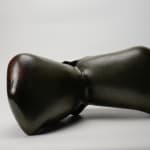Takiguchi Kazuo 滝口和男
H23.2 × W53 × D22.8 cm
Further images
-
(View a larger image of thumbnail 1
)

-
(View a larger image of thumbnail 2
)

-
(View a larger image of thumbnail 3
)

-
(View a larger image of thumbnail 4
)

-
(View a larger image of thumbnail 5
)

-
(View a larger image of thumbnail 6
)

-
(View a larger image of thumbnail 7
)

-
(View a larger image of thumbnail 8
)

-
(View a larger image of thumbnail 9
)

-
(View a larger image of thumbnail 10
)

-
(View a larger image of thumbnail 11
)

-
(View a larger image of thumbnail 12
)

-
(View a larger image of thumbnail 13
)

-
(View a larger image of thumbnail 14
)

-
(View a larger image of thumbnail 15
)

-
(View a larger image of thumbnail 16
)

-
(View a larger image of thumbnail 17
)

In his essay about the work of Takiguchi Kazuo, the art critic Kaneko Kenji aptly describes Takiguchi’s work with the phrase "taut rotundity." This description captures the essence of Takiguchi's slab-constructed stoneware, which features a rich, black iron glaze. The organic forms were heavily inspired by the sculptures of Henry Moore and Yagi Kazuo, with dynamic and sensitive surfaces. The real intrigue, however, lies in the sense of anthropomorphism, brought to life by Takiguchi's meditations on energy stemming from an object or vessel's internal action— an impression of movement and air within hollow spaces in pieces. The shapes of his vessels are unexpected, marked by seemingly random bumps and protrusions that nonetheless coalesce into a harmonious whole.
Takiguchi Kazuo is an acclaimed ceramic sculptor from the Kyoto area, is known for his unique pottery. His large pieces possess an anthropomorphic presence. He spent a short period studying with Kiyomizu Rokubei VI (1901-1980) and later with Yagi Kazuo (1918-1979). Additionally, he often visited Kondō Yutaka (1932-1983) and Fujihira Shin (1922-2012). Yagi’s emphasis on non-traditional, sculptural forms profoundly influenced Takiguchi. He also attended the Royal College of Arts in London, UK, where he graduated in 1992.
















